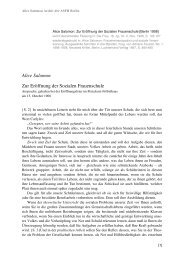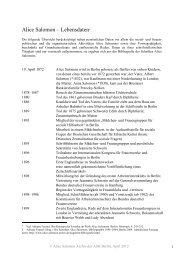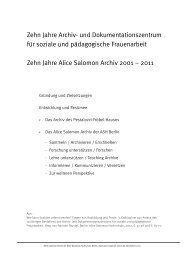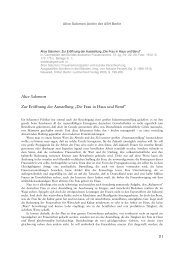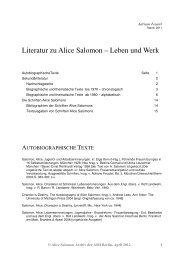Teaching Gender in Social Work - MailChimp
Teaching Gender in Social Work - MailChimp
Teaching Gender in Social Work - MailChimp
Create successful ePaper yourself
Turn your PDF publications into a flip-book with our unique Google optimized e-Paper software.
As we can see, the aim of Bojana Christova was to <strong>in</strong>struct visit<strong>in</strong>g<br />
nurses on how to create a space of trust and security with the mothers, while<br />
preserv<strong>in</strong>g their authority as powerful professional women who were different<br />
from “ord<strong>in</strong>ary” women even <strong>in</strong> terms of their outfits. Emotional communication<br />
was regulated. Female emotional closeness, empathy and friendship were<br />
required, but so too were professionalism, distance and control.<br />
This balance was a precondition for successful home visit<strong>in</strong>g practice.<br />
The first generation of visit<strong>in</strong>g nurses came from the middle and lower-middle<br />
class, which was especially affected <strong>in</strong> the post-war crisis years. The personal<br />
documents of nurses concern<strong>in</strong>g their personal and family situation, <strong>in</strong>dicate<br />
that they found it difficult to take care of their families alongside their professional<br />
work. It was important to encourage them, <strong>in</strong> their professional status as<br />
women responsible for the health and welfare of young mothers and babies.<br />
The case study <strong>in</strong>cludes such questions as:<br />
1. Analyse the recommendations of Bojana Chrostova to the visit<strong>in</strong>g<br />
nurses <strong>in</strong> Bulgaria.<br />
2. Why did the home visits of visit<strong>in</strong>g nurses need to have rules?<br />
3. What were the similarities to the recommendations for home<br />
visit<strong>in</strong>g practices <strong>in</strong> Victorian England?<br />
4. How did visit<strong>in</strong>g nurses establish their authority <strong>in</strong> the course<br />
of home visits?<br />
5. How did they establish relationships of trust with the visited<br />
mothers and women?<br />
Female Teachers – Advisors: Penetrat<strong>in</strong>g Homes <strong>in</strong> Villages<br />
In the second half of the 1920s, many child health units were opened <strong>in</strong> urban<br />
areas. Their biopolitical measures – to reduce <strong>in</strong>fant mortality and “help people<br />
to live” 15 – made them important social <strong>in</strong>stitutions for the urban poor. In comparison<br />
to the urban space, the lack of health units and other health and social<br />
<strong>in</strong>stitutions <strong>in</strong> rural areas was obvious. How could homes <strong>in</strong> villages be visited<br />
if there were an <strong>in</strong>sufficient number of doctors and nurses? Who could be the<br />
agent who was close to the young mothers and able to visit homes and talk to<br />
15<br />
Michel Foucalt, Trjabva da zashtitavame obshtestvoto (We have to defend society), (Sofia: LIK, 2003).<br />
135



